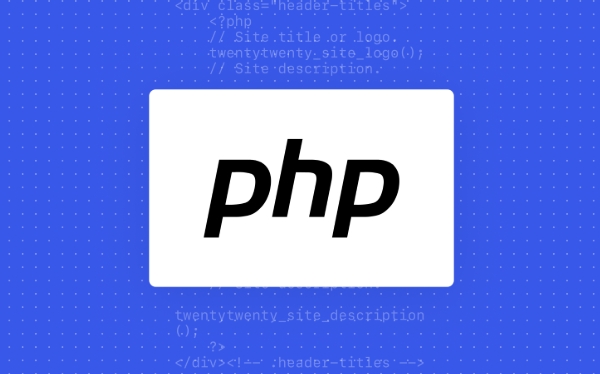How to parse a URL query string into variables with parse_str
Jul 09, 2025 am 12:35 AMTo extract variables from a URL query string in PHP, use the parse_str() function. 1. Pass the query string and an output array to convert parameters into an associative array. 2. For full URLs, first extract the query part using parse_url(). 3. Always provide a second argument to avoid variable injection risks. 4. Array-like parameters are automatically handled, preserving nested structures and multiple values when using array syntax. 5. Be mindful of proper encoding, case sensitivity, and duplicate key behavior where only the last value remains unless array notation is used.

When you need to extract variables from a URL query string in PHP, parse_str() is a straightforward function that does exactly that. It takes the query string and converts it into individual variables or an associative array.

Basic usage: Turn a query string into variables
You can use parse_str() like this:
parse_str("name=John&age=30", $output);
print_r($output);This will give you an array like:

Array
(
[name] => John
[age] => 30
)If you're working directly with a full URL (like http://example.com?page=1&sort=asc), you might want to first extract the query part using parse_url() before passing it to parse_str().
Using parse_str() safely in modern PHP
By default, parse_str() will create actual variables in your current scope if you don’t provide the second argument. For example:

parse_str("username=admin&role=guest");
echo $username; // Outputs: adminWhile convenient, this can be risky—especially if the input comes from user-submitted data—as it may overwrite existing variables unintentionally. That’s why it's better to always pass a second parameter to store results in an array:
parse_str("username=admin&role=guest", $data);
echo $data['role']; // Outputs: guestThis avoids variable injection issues and makes your code more predictable.
Handling nested parameters and arrays in query strings
URLs often include array-like parameters such as:
filter[size][]=small&filter[size][]=medium
Using parse_str() on this will correctly convert them into an array:
parse_str("filter[size][]=small&filter[size][]=medium", $params);
print_r($params);Result:
Array
(
[filter] => Array
(
[size] => Array
(
[0] => small
[1] => medium
)
)
)So if you’re dealing with complex query structures, especially those generated by HTML forms with array-style names, parse_str() handles nesting automatically.
A few common pitfalls to watch for
- Encoding matters: Make sure the query string is properly URL-encoded. If it’s not, unexpected results may occur.
- Case sensitivity: Parameter names are case-sensitive, so
id=1andID=2will be treated as separate entries. - Duplicates get overwritten: If a key appears more than once, only the last value remains unless you use array syntax (
[]).
For example:
parse_str("color=red&color=blue", $result);
// $result['color'] will be 'blue'But with array notation:
parse_str("color[]=red&color[]=blue", $result);
// $result['color'] will be ['red', 'blue']So if you expect multiple values for the same key, always use the array syntax in the query string.
That’s how you work with parse_str() effectively. It’s simple but powerful, especially when handling query strings in PHP-based applications. Just keep in mind the behavior around variable assignment and duplicate keys, and you should be good to go.
The above is the detailed content of How to parse a URL query string into variables with parse_str. For more information, please follow other related articles on the PHP Chinese website!

Hot AI Tools

Undress AI Tool
Undress images for free

Undresser.AI Undress
AI-powered app for creating realistic nude photos

AI Clothes Remover
Online AI tool for removing clothes from photos.

Clothoff.io
AI clothes remover

Video Face Swap
Swap faces in any video effortlessly with our completely free AI face swap tool!

Hot Article

Hot Tools

Notepad++7.3.1
Easy-to-use and free code editor

SublimeText3 Chinese version
Chinese version, very easy to use

Zend Studio 13.0.1
Powerful PHP integrated development environment

Dreamweaver CS6
Visual web development tools

SublimeText3 Mac version
God-level code editing software (SublimeText3)
 PHP Variable Scope Explained
Jul 17, 2025 am 04:16 AM
PHP Variable Scope Explained
Jul 17, 2025 am 04:16 AM
Common problems and solutions for PHP variable scope include: 1. The global variable cannot be accessed within the function, and it needs to be passed in using the global keyword or parameter; 2. The static variable is declared with static, and it is only initialized once and the value is maintained between multiple calls; 3. Hyperglobal variables such as $_GET and $_POST can be used directly in any scope, but you need to pay attention to safe filtering; 4. Anonymous functions need to introduce parent scope variables through the use keyword, and when modifying external variables, you need to pass a reference. Mastering these rules can help avoid errors and improve code stability.
 How to handle File Uploads securely in PHP?
Jul 08, 2025 am 02:37 AM
How to handle File Uploads securely in PHP?
Jul 08, 2025 am 02:37 AM
To safely handle PHP file uploads, you need to verify the source and type, control the file name and path, set server restrictions, and process media files twice. 1. Verify the upload source to prevent CSRF through token and detect the real MIME type through finfo_file using whitelist control; 2. Rename the file to a random string and determine the extension to store it in a non-Web directory according to the detection type; 3. PHP configuration limits the upload size and temporary directory Nginx/Apache prohibits access to the upload directory; 4. The GD library resaves the pictures to clear potential malicious data.
 Commenting Out Code in PHP
Jul 18, 2025 am 04:57 AM
Commenting Out Code in PHP
Jul 18, 2025 am 04:57 AM
There are three common methods for PHP comment code: 1. Use // or # to block one line of code, and it is recommended to use //; 2. Use /.../ to wrap code blocks with multiple lines, which cannot be nested but can be crossed; 3. Combination skills comments such as using /if(){}/ to control logic blocks, or to improve efficiency with editor shortcut keys, you should pay attention to closing symbols and avoid nesting when using them.
 How Do Generators Work in PHP?
Jul 11, 2025 am 03:12 AM
How Do Generators Work in PHP?
Jul 11, 2025 am 03:12 AM
AgeneratorinPHPisamemory-efficientwaytoiterateoverlargedatasetsbyyieldingvaluesoneatatimeinsteadofreturningthemallatonce.1.Generatorsusetheyieldkeywordtoproducevaluesondemand,reducingmemoryusage.2.Theyareusefulforhandlingbigloops,readinglargefiles,or
 Tips for Writing PHP Comments
Jul 18, 2025 am 04:51 AM
Tips for Writing PHP Comments
Jul 18, 2025 am 04:51 AM
The key to writing PHP comments is to clarify the purpose and specifications. Comments should explain "why" rather than "what was done", avoiding redundancy or too simplicity. 1. Use a unified format, such as docblock (/*/) for class and method descriptions to improve readability and tool compatibility; 2. Emphasize the reasons behind the logic, such as why JS jumps need to be output manually; 3. Add an overview description before complex code, describe the process in steps, and help understand the overall idea; 4. Use TODO and FIXME rationally to mark to-do items and problems to facilitate subsequent tracking and collaboration. Good annotations can reduce communication costs and improve code maintenance efficiency.
 Quick PHP Installation Tutorial
Jul 18, 2025 am 04:52 AM
Quick PHP Installation Tutorial
Jul 18, 2025 am 04:52 AM
ToinstallPHPquickly,useXAMPPonWindowsorHomebrewonmacOS.1.OnWindows,downloadandinstallXAMPP,selectcomponents,startApache,andplacefilesinhtdocs.2.Alternatively,manuallyinstallPHPfromphp.netandsetupaserverlikeApache.3.OnmacOS,installHomebrew,thenrun'bre
 How to access a character in a string by index in PHP
Jul 12, 2025 am 03:15 AM
How to access a character in a string by index in PHP
Jul 12, 2025 am 03:15 AM
In PHP, you can use square brackets or curly braces to obtain string specific index characters, but square brackets are recommended; the index starts from 0, and the access outside the range returns a null value and cannot be assigned a value; mb_substr is required to handle multi-byte characters. For example: $str="hello";echo$str[0]; output h; and Chinese characters such as mb_substr($str,1,1) need to obtain the correct result; in actual applications, the length of the string should be checked before looping, dynamic strings need to be verified for validity, and multilingual projects recommend using multi-byte security functions uniformly.
 Learning PHP: A Beginner's Guide
Jul 18, 2025 am 04:54 AM
Learning PHP: A Beginner's Guide
Jul 18, 2025 am 04:54 AM
TolearnPHPeffectively,startbysettingupalocalserverenvironmentusingtoolslikeXAMPPandacodeeditorlikeVSCode.1)InstallXAMPPforApache,MySQL,andPHP.2)Useacodeeditorforsyntaxsupport.3)TestyoursetupwithasimplePHPfile.Next,learnPHPbasicsincludingvariables,ech






